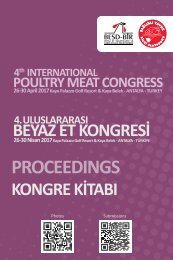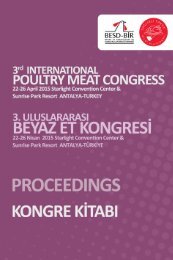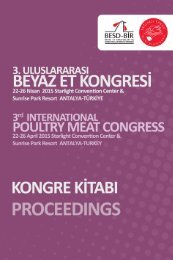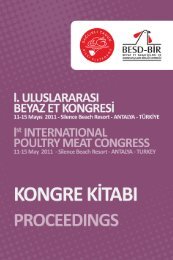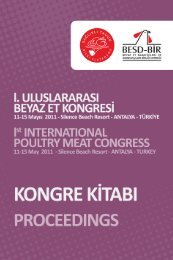- Page 1:
Fotoğraflar Bildiriler
- Page 5 and 6:
TAM METİNLER KİTABI Yayın Hakkı
- Page 7 and 8:
Önsöz Organizasyon ve Komiteler P
- Page 9 and 10:
Beyaz Et Sektörünün Değerli Pay
- Page 11 and 12:
S11 S12 DK08 S13 S14 S15 DK09 S16 S
- Page 13 and 14:
S35 DK20 S36 S37 DK21 S38 S39 S40 S
- Page 15 and 16:
P26 P27 P28 P29 P30 P31 P32 P33 P34
- Page 17 and 18:
P64 Etlik piliçlerde rasyon amino
- Page 19 and 20:
DK 01 Broyler Sektörünün Sürdü
- Page 21 and 22:
Kanatlıların Çevresel Etkisi Tar
- Page 23 and 24:
Global Karşılaştırılabilirlik
- Page 25 and 26:
edilen bilgileri kullanarak seçtik
- Page 27 and 28:
Beş Özgürlüğü [ aç ve susuz
- Page 29 and 30:
4) Foresight. 2011. The Future of F
- Page 31 and 32:
DK 02 Genetik ve Yetiştirmenin Bro
- Page 33 and 34:
sahip etlik piliçler aynı zamanda
- Page 35 and 36:
öngörmektedir. Son dönemde basit
- Page 37 and 38:
14. güne kadar 28-29°C, 21.güne
- Page 39 and 40:
70 60 50 Canlı ağırlıklar-2.gü
- Page 41 and 42:
Teşekkür Bu proje TÜBİTAK taraf
- Page 43 and 44:
Giriş Etlik piliç performansını
- Page 45 and 46:
karşılaştırma metodundan yararl
- Page 47 and 48:
Çıkış Zamanı; · Geç dönemde
- Page 49 and 50:
S 03 Etlik Piliç Ebeveyn Hatların
- Page 51 and 52:
Tablo 1. Ebeveyn hatlarının yumur
- Page 53 and 54:
Tablo 4. Ebeveyn hatları ve melezl
- Page 55 and 56:
Cobb500, 2016a. Parent stock perfor
- Page 57 and 58:
57
- Page 59 and 60:
59
- Page 61 and 62:
61
- Page 63 and 64:
63
- Page 65 and 66:
S 04 Dünyada Genetiği Değiştiri
- Page 67 and 68:
İçeriklerindeki oleik asit miktar
- Page 69 and 70:
açan önemli faktörler arasında
- Page 71 and 72:
yarattığı ekonomik refah artış
- Page 73 and 74:
Sonuç Çağın bir getirisi olan t
- Page 75 and 76:
2015. 5. Fagerström T, Dixelius C,
- Page 77 and 78:
DK 04 Tavuk Etinde Antibiyotik Dire
- Page 79 and 80:
Microbiol. Infect. 22, 130-140 (201
- Page 81 and 82:
halk sağlığı açısından risk
- Page 83 and 84:
spp. varlığının araştırıldı
- Page 85 and 86:
Spain. Int J Food Microbiol. 2003;
- Page 87 and 88:
Materyal ve Metot Çalışmada Kars
- Page 89 and 90:
pozitif olarak belirlenirken sadece
- Page 91 and 92:
S 08 Tavuk Göğüs Etinde Farklı
- Page 93 and 94:
Sumak yağının ekstraksiyonu Ara
- Page 95 and 96:
Tartışma ve Sonuç Araştırma so
- Page 97 and 98:
Kaynaklar 1. Karagöz A, Şireli UT
- Page 99 and 100:
oranı %2’yi geçmemelidir. İlk
- Page 101 and 102:
Normal süreçte embriyo 14. Günde
- Page 103 and 104:
DK 06 Kuluçka Sırasında Yumurtal
- Page 105 and 106:
Şekil 2. Sürü yaşı ve kuluçka
- Page 107 and 108:
Tablo 2. Kuluçkanın ilk 2 günün
- Page 109 and 110:
Kaynaklar Elibol O., Turkoglu M., P
- Page 111 and 112:
Oksijen canlı organizma hücreleri
- Page 113 and 114:
K 0-21 : Kontrol; O 0-11 : Embriyo
- Page 115 and 116:
Sonuç olarak, yüksek rakım altı
- Page 117 and 118:
S 10 Kuluçkanın Erken ve Geç Dö
- Page 119 and 120:
Tablo 1. Kuluçkanın erken ve geç
- Page 121 and 122:
2. Kampschöer MVT. Setting standar
- Page 123 and 124:
ulaşabilir. Enfekte broyler damız
- Page 125 and 126:
American Wild Birds, 1994-2015. Jou
- Page 127 and 128:
ve yumurta verimindeki azalış ve
- Page 129 and 130:
yaşandığında hemen yardım alı
- Page 131 and 132:
gallisepticum: current and developi
- Page 133 and 134:
39. Cockerill FR. Application of ra
- Page 135 and 136:
çıkmakta ve bu nedenle genotiplen
- Page 137 and 138:
küçülmüş olduğu görüldü. B
- Page 139 and 140:
6. Toroghi R, Kataria M, Verma KC,
- Page 141 and 142:
Karbohidrazlar: Ana grup ksilanazla
- Page 143 and 144:
ağırsak içeriği viskozitesini a
- Page 145 and 146:
S 13 Mısır-Soya Ağırlıklı Bro
- Page 147 and 148:
yaşlardakiler 14 farklı yem ile b
- Page 149 and 150:
Enzim kompleksinin dahil edilmesi d
- Page 151 and 152:
S 15 NSP Enzim ve Farklı Düzeyler
- Page 153 and 154:
Sonuçlar ve Tartışma Bu çalış
- Page 155 and 156:
Tablo 3. Negatif Kontrol Grubunda B
- Page 157 and 158:
Cowieson, A.J., Roos, 2016. F.F., T
- Page 159 and 160:
Miyopatiler için kalıtım dereces
- Page 161 and 162:
Zuidhof, M. J., B. L. Schneider, V.
- Page 163 and 164:
çizgili göğüs kasındaki beyaz
- Page 165 and 166:
Bulgular ve Tartışma Kuttappan ve
- Page 167 and 168:
Etkileşim WS değeri × zaman Sakl
- Page 169 and 170:
S 17 Ultrases Önişlemi Uygulanara
- Page 171 and 172:
İşlem örneklerin su alımının
- Page 173 and 174:
Tablo 1. Farklı koşullarda ultras
- Page 175 and 176:
S 18 Marinasyon ve Sous Vide Pişir
- Page 177 and 178:
elirlenmiştir. Fizikokimyasal anal
- Page 179 and 180:
90 G MG B MB 6,8 G MG B MB L* değe
- Page 181 and 182:
olarak düşünülmektedir. Ayrıca
- Page 183 and 184:
Yavaş gelişen etlik piliç genoti
- Page 185 and 186:
et pH’sında önemli sapmalara yo
- Page 187 and 188:
24. Snedecor GW Cochran WG. Statist
- Page 189 and 190:
hatalıkların sıklığını ve ö
- Page 191 and 192:
olarak; her 10 çocuktan biri bodur
- Page 193 and 194:
DK 11 Çocukluk Dönemi Beslenmesin
- Page 195 and 196:
koyar. Bazıları aynı zamanda bü
- Page 197 and 198:
PA, Sunkara LT. Growth promoters an
- Page 199 and 200:
dünyada kişi başına düşen top
- Page 201 and 202:
Çizelge 1. Bağımlı ve bağıms
- Page 203 and 204:
Model sonuçlarına ait birim (marj
- Page 205 and 206:
yapısında olumlu değişimlerin m
- Page 207 and 208:
S 21 Kaplanmış Organik Asit Uçuc
- Page 209 and 210:
ve vizüalizasyon aracı olan Calyp
- Page 211 and 212:
Şekil 3. 14 ve 28. günlerde korun
- Page 213 and 214:
Pathogens: Communicating Current Re
- Page 215 and 216:
endişesi, yakın zamanda yeni hast
- Page 217 and 218:
İşlem gören hayvanların canlı
- Page 219 and 220:
Sonuç Bu senaryoda, yemdeki organi
- Page 221 and 222:
ir durumdur. Bekleme süreci diğer
- Page 223 and 224:
süresinin uzamasına bağlı olara
- Page 225 and 226:
Çizelge 2. Rasyona prebiyotik katk
- Page 227 and 228:
S 24 Farklı Enerji Seviyesine Sahi
- Page 229 and 230:
Büyüme Performans Sonuçları 0-4
- Page 231 and 232:
Sonuç Mevcut çalışmanın sonucu
- Page 233 and 234:
S 25 Alg-Kil Kompleksinin Broyler P
- Page 235 and 236:
(tek yönlü ANOVA). Ortalamalar ar
- Page 237 and 238:
Klinik Biyokimya Deneme AFLA FUM Ne
- Page 239 and 240:
analizde organik ve geleneksel yön
- Page 241 and 242:
8. http://www.oie.int/for-the-media
- Page 243 and 244:
Giriş Ülkemizde Avrupa Birliği D
- Page 245 and 246:
ile bazı ürün bilgilerinde mevcu
- Page 247 and 248:
S 27 Konya İlinde Tavuk Eti ve Ür
- Page 249 and 250:
olduğunu düşündüğünü belirt
- Page 251 and 252:
Giriş Uluslararası Çalışma Ör
- Page 253 and 254:
yaptığı işin risklerini bildiğ
- Page 255 and 256:
Sonuç ve Öneriler Çalışanları
- Page 257 and 258:
DK 13 Etlik Piliçlerin Solunum Yol
- Page 259 and 260:
Tortikollis;NDV ve AIV enfeksiyonla
- Page 261 and 262:
ağırsak mikrobiyotasının 10 5 -
- Page 263 and 264:
DK 14 Enfeksiyöz Laringotrachetis
- Page 265 and 266:
· ILT hastalığı farklı epidemi
- Page 267 and 268:
Bu aşılar ölüm oranlarını ön
- Page 269 and 270:
13. Zavala LD. Epizootiology of inf
- Page 271 and 272:
Giriş Infeksiyöz bronşitis (IB)
- Page 273 and 274:
Şekil 2. Çalışmada pozitif sapt
- Page 275 and 276:
Şekil 5. Aşılı broyler serumlar
- Page 277 and 278:
6- Callison SA, Hilt DA, Boynton TO
- Page 279 and 280:
yemlerin yapısal özelliklerine, o
- Page 281 and 282:
yerine daha yeni methgenomik yakla
- Page 283 and 284:
ile prebiyotikler de rekabete dayan
- Page 285 and 286:
introducing the concept of prebioti
- Page 287 and 288:
digestibility and intestinal microf
- Page 289 and 290:
S 31 Esansiyel yağlar ve Organik A
- Page 291 and 292:
Bulgular ve Tartışma Broyler karm
- Page 293 and 294:
post-slaughter parameters and meat
- Page 295 and 296:
DK 16 Dünya Tavukçuluğunda Brezi
- Page 297 and 298:
DK 17 Broyler Piliç Kümeslerinde
- Page 299 and 300:
kadar ihtiyaç duyduğundan bağım
- Page 301 and 302:
S 33 Farklı Yetiştirme Sisteminde
- Page 303 and 304:
Tablo 1. Ördeklerin canlı ağırl
- Page 305 and 306:
Canlı Ağırlık (g) 3000 2000 100
- Page 307 and 308:
Tartışma ve Sonuç Bu araştırma
- Page 309 and 310:
S 34 Etlik Piliçleri Düşük-Yük
- Page 311 and 312:
su kısıtlaması uygulanmamıştı
- Page 313 and 314:
Şekil 2. Piliçlerde ayak ve kanat
- Page 315 and 316:
Akan kan miktarının, AC- chirp-50
- Page 317 and 318:
uygulamalarının etlik piliçlerin
- Page 319 and 320:
spesifikliği ile karakterizedir. S
- Page 321 and 322:
tarafından daha iyi kullanılması
- Page 323 and 324:
artırabilecek tüm parametrelere
- Page 325 and 326:
Tablo 2. Piliçlerde kullanılan ve
- Page 327 and 328:
DK 19 Avian İnfluenza Hastalığı
- Page 329 and 330:
göçmen kuşlar ve evcil kanatlıl
- Page 331 and 332:
yanı sıra bazı ülkeler ithal ed
- Page 333 and 334:
sevklerinde nakil araçlarının re
- Page 335 and 336:
Tavuk kanından elde edilen ham enz
- Page 337 and 338:
DK 20 Broyler Damızlıklarda Prote
- Page 339 and 340:
etkilemiştir. Ortalama olarak, bu
- Page 341 and 342:
yağ pedi, bu farkın nedeni olmakl
- Page 343 and 344:
5. Daha az yem vermek, beslenme zam
- Page 345 and 346:
Ekmay, R. D. 2011. Protein utilizat
- Page 347 and 348:
Renema, R. A., T. G. V. Moraes, and
- Page 349 and 350:
S 36 25-Hidroksi Kolekalsiferol ve
- Page 351 and 352:
Şekil. 1. Kontrol ve 25OHD 3 ile b
- Page 353 and 354:
GEN KONTROL 25OHD3 + CTX SOY ETKISI
- Page 355 and 356:
S 37 Kanatlılarda Antioksidan Sist
- Page 357 and 358:
Kanatlılarda Antioksidan Sistemler
- Page 359 and 360:
Selenyumla Zenginleştirilmiş Maya
- Page 361 and 362:
Sonuç Sonuç olarak, mevcut diğer
- Page 363 and 364:
DK 21 Kanatlı Eti Üretiminde Mikr
- Page 365 and 366:
kullanılan fiziksel teknikler baş
- Page 367 and 368:
ve uluslararası kuruluşlar aralar
- Page 369 and 370:
taşıma araçlarıyla, infekte hay
- Page 371 and 372:
ve optimize edildi. Primer bağlanm
- Page 373 and 374:
2. Saini, J. K. 2008. “Validating
- Page 375 and 376:
S 39 Kanatlı Etinde Antimikrobiyel
- Page 377 and 378:
olumsuz etkilememesi gerekir. Antim
- Page 379 and 380:
olabileceği çalışmalarda vurgul
- Page 381 and 382:
S 40 Kanatlı Kesimhane Atık Sular
- Page 383 and 384:
8 ’e kadar TSB (Oxoid CM0129) ile
- Page 385 and 386:
liman suyundan izole edilen, altı
- Page 387 and 388:
S 41 Farklı Meşe Pelidi Ekstraktl
- Page 389 and 390:
analizlerine tabi tutulmuştur. Ça
- Page 391 and 392:
Çizelge 2. 2°C’de 7gün süreyl
- Page 393 and 394:
Teşekkür Materyal sağlamadaki ka
- Page 395 and 396:
Nekrotik enteritis, b-pore oluştur
- Page 397 and 398:
Son on yıl piliç bağırsakların
- Page 399 and 400:
Tsiouris, V., Georgopoulou, I., Bat
- Page 401 and 402:
S 42 Erken Civciv Ölümleri İle
- Page 403 and 404:
Tartışma ve Sonuç Moleküler biy
- Page 405 and 406:
Materyal ve Metod DNA İzolasyonu
- Page 407 and 408:
S 44 Tavuk Escherichia coli İzolat
- Page 409 and 410:
Bulgular İzolasyon ve İdentifikas
- Page 411 and 412:
SXT direnci bulunduğunu bildirirle
- Page 413 and 414:
and Textbook of Diagnostic Microbio
- Page 415 and 416:
DK 23 Sürdürülebilir Broyler Ür
- Page 417 and 418:
417
- Page 419 and 420:
419
- Page 421 and 422:
421
- Page 423 and 424:
Cobb 2006 yılından 2012 yılına
- Page 425 and 426:
Şekil 1: 1. Denemedeki etlik pili
- Page 427 and 428:
S 45 Bitkisel Kökenli Bir Karış
- Page 429 and 430: POSTER TEBLİĞLER 429
- Page 431 and 432: Bütirik asit doğal halde uçucu v
- Page 433 and 434: Sodyum Bütiratın Direkt Bakterisi
- Page 435 and 436: Sciences 2011; 11: 507-511. 14. Pan
- Page 437 and 438: P 02 Kanatlı Beslemede Yeni Bir Ka
- Page 439 and 440: edilen esansiyel yağ karışımın
- Page 441 and 442: theintestines of broiler chickens.
- Page 443 and 444: değerliliğinin yüksek olması ay
- Page 445 and 446: yeterli ve dengeli beslenmeyi kapsa
- Page 447 and 448: P 04 Kişniş (Coriendrum sativum L
- Page 449 and 450: Çizelge 1. Kişniş tohumunun besi
- Page 451 and 452: değerlerini düzenleyici, antimikr
- Page 453 and 454: P 05 Tarçının (Cinnamomum spp.)
- Page 455 and 456: Çizelge 1. Tarçının (Cinnamonum
- Page 457 and 458: kolesterol ve trigliserid düzeyler
- Page 459 and 460: 23. Sampath HKR, Atapattu NSBM. Eff
- Page 461 and 462: Şekil 1. Atımlı elektrik akımı
- Page 463 and 464: kuzu etinde kavrulmuş et kokusuna
- Page 465 and 466: 22) MA, O., HAMID, N., OEY, I., KAN
- Page 467 and 468: P 07 Elektrolize Suyun Kanatlı Et
- Page 469 and 470: son derece tehlikeli sonuçlar da o
- Page 471 and 472: 1778-1784. 18. Kiura, H., Sano, K.,
- Page 473 and 474: P 08 Kanatlı Et Endüstrisinde Ozo
- Page 475 and 476: Ozonun Etki Mekanizması Ozonun etk
- Page 477 and 478: ulaşmadan tavuk numunelerinde 2x10
- Page 479: Depolanması Sırasında Kalitesind
- Page 483 and 484: Biyojen Aminlerin Toksikolojik Etki
- Page 485 and 486: sırasıyla 7.3 ve 17.9 mg/kg olara
- Page 487 and 488: fermented sausages. Meat Sci. 72(1)
- Page 489 and 490: 44. Yeğin, S., Üren, A. 2008. Gı
- Page 491 and 492: Çizelge 1. Et Türlerine Göre Bil
- Page 493 and 494: Çizelge 3. Üretilen Hindi Salamla
- Page 495 and 496: P 11 Tavuk Etinin İnsan Beslenmesi
- Page 497 and 498: Tavuk etinin demir içeriği kırm
- Page 499 and 500: P 12 Benin’de Tavuk Eti Sektörü
- Page 501 and 502: girdisi ve kanatlı ekipmanı tedar
- Page 503 and 504: P 13 Kanatlı Eti Üretiminde Yeti
- Page 505 and 506: piliç yetiştirme sistemlerinin s
- Page 507 and 508: A B Grafik 2. Besin maddelerine gö
- Page 509 and 510: production systems. Poultry Science
- Page 511 and 512: Materyal ve Metot Çalışmada 480
- Page 513 and 514: kullanılan gruplarda arttığı (P
- Page 515 and 516: 12. Abildgaard L, Hoijberg O, Schra
- Page 517 and 518: P 15 Bıldırcınlarda Aydınlatman
- Page 519 and 520: müşteriler arasında artan bir po
- Page 521 and 522: olayı doğrudan etkilediği saptan
- Page 523 and 524: Hastane mutfak çalışanları tüm
- Page 525 and 526: olması ilk sırayı almıştır. S
- Page 527 and 528: P 17 Serbest Gezinmeli ve Kapalı S
- Page 529 and 530: Bu çalışmada ördeklerin, entans
- Page 531 and 532:
Çizelge 2. Yetiştirme sistemi ve
- Page 533 and 534:
çalışmaya göre fazla olmasında
- Page 535 and 536:
P 18 Japon Bıldırcınlarında 5.
- Page 537 and 538:
Tablo 2. Kontrol ve seleksiyon grup
- Page 539 and 540:
canlı ağırlık değeri ile 5. ha
- Page 541 and 542:
P 19 Piliç Boyun Derisi Örnekleri
- Page 543 and 544:
ERIC-PCR (Enterobacterial Repetitiv
- Page 545 and 546:
seviyededir. Türkiye’de kanatlı
- Page 547 and 548:
P 20 Probiyotik Bakterilerin Tavuk
- Page 549 and 550:
Numune hazırlama:Taze dışkı ör
- Page 551 and 552:
DRBC Besi Ortamında Mikrobiyal Yü
- Page 553 and 554:
Kaynaklar Yalçın S., Çiftçi İ.
- Page 555 and 556:
ark 2007; R 2007) kullanılarak ü
- Page 557 and 558:
Kaynaklar Aulchenko YS, Ripke S, Is
- Page 559 and 560:
uçlara yaklaşık 25 bazlık adapt
- Page 561 and 562:
Bu çalışma sonucunda elde edilen
- Page 563 and 564:
Kaynaklar 1. Dijk EL, Auger H, Jasz
- Page 565 and 566:
Materyal ve Metod Bu amaçla %19.22
- Page 567 and 568:
tucudan sonrada pelet yemde nem mik
- Page 569 and 570:
P 25 Tavuk Karkaslarında Post-Chil
- Page 571 and 572:
kullanılmıştır. İlgili dilüsy
- Page 573 and 574:
Tablo 1. Deney gruplarına ait mikr
- Page 575 and 576:
Kanatlı hayvan yetiştiriciliğind
- Page 577 and 578:
Geçmiş yıllarda çoğu araştır
- Page 579 and 580:
P 27 Kanatlı Etinde Oksidatif Bozu
- Page 581 and 582:
oksidasyonu, su tutma kapasitesinin
- Page 583 and 584:
antioxidants, redox reactions, and
- Page 585 and 586:
40. Ladikos D, Lougovois V. Lipid o
- Page 587 and 588:
daha düşük olduğunu tespit etmi
- Page 589 and 590:
da 0-3 gün ve 4-6 gün 38.6°C kab
- Page 591 and 592:
P 29 Fourier Dönüşümlü Kızıl
- Page 593 and 594:
Bulgular Dört markaya ait 16 farkl
- Page 595 and 596:
5. Nabedryk, E.,Garavito, R., Breto
- Page 597 and 598:
sağlayan bir yöntemdir (4).Bu yö
- Page 599 and 600:
alan ~3340 cm -1 dalga sayısındak
- Page 601 and 602:
P 31 Kuluçkanın Çıkış Dönemi
- Page 603 and 604:
Çizelge 1. Gruplarda gerçekleşen
- Page 605 and 606:
12. Janke O, Tzschentke B, Boerjan
- Page 607 and 608:
Mısır unu ve nişastası içermi
- Page 609 and 610:
verim sonuçları 80.84 ile 82.45 a
- Page 611 and 612:
Middle East Technical University (U
- Page 613 and 614:
sayıları ve relatif sıklıkları
- Page 615 and 616:
P 34 Broilerlerde Bağırsak Mikrob
- Page 617 and 618:
Kaynaklar 1. Stanley D, Hughes RJ,
- Page 619 and 620:
testlerin ve parametrelerin tümü
- Page 621 and 622:
P 36 Ticari Broiler ve Free-Range T
- Page 623 and 624:
Tablo 1. İncelenen gruplara özel
- Page 625 and 626:
P 38 Kümes Hayvanlarında Solucanl
- Page 627 and 628:
Çizelge 2. Solucanların besin mad
- Page 629 and 630:
ppm), Hg (0.00 ppm) ve Pb (3.39 ppm
- Page 631 and 632:
earthworm (Perionyx excavatus) for
- Page 633 and 634:
frekans düşük güç uygulaması
- Page 635 and 636:
Tablo 2. Ultrases önişlemi uygula
- Page 637 and 638:
ulunan Brezilya, Rusya, Hindistan v
- Page 639 and 640:
yapılan trend analizine göre (Y=6
- Page 641 and 642:
P 41 Izgaralı Zemin Sisteminde Yet
- Page 643 and 644:
Tablo 2: Genotipin broyler et kalit
- Page 645 and 646:
12. Wang KH, Shi SR, Dou TC, Sun HJ
- Page 647 and 648:
P 42 Karma Yemlere Klinoptilolit İ
- Page 649 and 650:
Uçucu yağ asitleri sekum fermenta
- Page 651 and 652:
P 43 Kazlarda Et Kalite Özellikler
- Page 653 and 654:
Çizelge 2. Kazlarda göğüs ve bu
- Page 655 and 656:
Çizelge 5. Kazlarda yağ sitlerind
- Page 657 and 658:
24. Kocakaya M., Boz MA. Halk Elind
- Page 659 and 660:
arındırılan kafes sistemi ve ız
- Page 661 and 662:
Bulgular Büyüme performansı:Dene
- Page 663 and 664:
3. Dawkins MS, Donnelly CA, Jones T
- Page 665 and 666:
Besin Maddeleri - Gen Ekspresyon Me
- Page 667 and 668:
Şekil 2. DNA metilasyonu ve histon
- Page 669 and 670:
Pankreatik hücrelerde, insülin se
- Page 671 and 672:
Physiological Genomics. 2004; 16, 1
- Page 673 and 674:
içerikli olmaktadır (4,5). Kullan
- Page 675 and 676:
Tablo 1. Rasyonların yapısı (g/k
- Page 677 and 678:
miktarı odun talaşına göre %1.3
- Page 679 and 680:
P 47 Keçiboynuzu Ürünlerine Β-1
- Page 681 and 682:
2’de verilmektedir. Bu deneme Ank
- Page 683 and 684:
ürün olacağı düşünülmektedi
- Page 685 and 686:
Tablo 7. Grupların 35. günde seka
- Page 687 and 688:
P 48 Etlik Damızlık Tavuk Yetişt
- Page 689 and 690:
ildirilmiştir. 42. gün canlı ağ
- Page 691 and 692:
9. Nestor K, Bacon W, Renner P. The
- Page 693 and 694:
P 49 Piliç Eti Üretiminde Sözle
- Page 695 and 696:
Türkiye’de 2005-2015 dönemi iç
- Page 697 and 698:
kalınmamaktadır. Rekabetçi pazar
- Page 699 and 700:
Antimikrobiyal Peptidlerin Yapısı
- Page 701 and 702:
akteriyosinlerinin ölümcül etkil
- Page 703 and 704:
16. Riley MA, Gordon DM. The ecolog
- Page 705 and 706:
Lipoik Asit’in Yapısı ve Metabo
- Page 707 and 708:
Sonuç olarak, LA hem yağda hem de
- Page 709 and 710:
P 52 Etlik Piliç Rasyonlarında Ha
- Page 711 and 712:
(29). Yulaf kavuzunun, sindirim kan
- Page 713 and 714:
14. Svihus B, Hetland H, Choct M, S
- Page 715 and 716:
P 53 Etlik Piliçlerde Yeme İlave
- Page 717 and 718:
yaprağı ilavesinin oksidasyonu ö
- Page 719 and 720:
22. Liu RH. Health benefits of frui
- Page 721 and 722:
P 54 Broiler Yemi Üretiminde Salmo
- Page 723 and 724:
eyaletinden farklı hammadde örnek
- Page 725 and 726:
sayede daha üst düzey bir dekonta
- Page 727 and 728:
ortam sağlamaktadır. · Fabrikada
- Page 729 and 730:
P 55 Etlik Piliçlerin Beslenmesind
- Page 731 and 732:
yanı sıra, 90°C’de şartlandı
- Page 733 and 734:
(4). Farklı buğday varyetelerinde
- Page 735 and 736:
17. Corzo, A., Mejia, L., Loar, I.I
- Page 737 and 738:
P 56 Etlik Piliç Damızlıklarda V
- Page 739 and 740:
performans üzerine ve kemik minera
- Page 741 and 742:
yumurta kalitesi kriterlerinden yum
- Page 743 and 744:
P 57 Broyler Yemlerinde Mikotoksin
- Page 745 and 746:
Şekil 1: Mikotoksinlerin kanatlıl
- Page 747 and 748:
Mikotoksinlerin İmmun Sisteme Etki
- Page 749 and 750:
P 58 Mikotoksin Bağlayıcı İçer
- Page 751 and 752:
P 59 Tavuk MDM Posasından Asidik K
- Page 753 and 754:
Fiziksel ve Kimyasal Analizler Elde
- Page 755 and 756:
Sonuç ve Tartışma Asidik ekstrak
- Page 757 and 758:
P 60 Anaç Tavuk Etinden Yapılan K
- Page 759 and 760:
Bulgular ve Tartışma Yanıt Yüze
- Page 761 and 762:
4 Lic* bic* COU (%) Lic* bic* aic*
- Page 763 and 764:
Sonuç Hayvansal protein ihtiyacın
- Page 765 and 766:
Materyal ve Metot Bu araştırmanı
- Page 767 and 768:
Fermente ürünleri ne sıklıkla (
- Page 769 and 770:
Tartışma ve Sonuç Ankete katıla
- Page 771 and 772:
Materyal ve Metot Çalışma, Britt
- Page 773 and 774:
Tablo 2. Hayvanların zooteknik per
- Page 775 and 776:
P 63 Alg Bazlı Kompleks Karışım
- Page 777 and 778:
Gumboro titrelerinin varyasyonunun
- Page 779 and 780:
miktarının azaltılmak istenmesi,
- Page 781 and 782:
Farklı Büyütme Dönemlerinde Ami
- Page 783:
Poult. Res. 14:69-76 9. Fanatico, A





